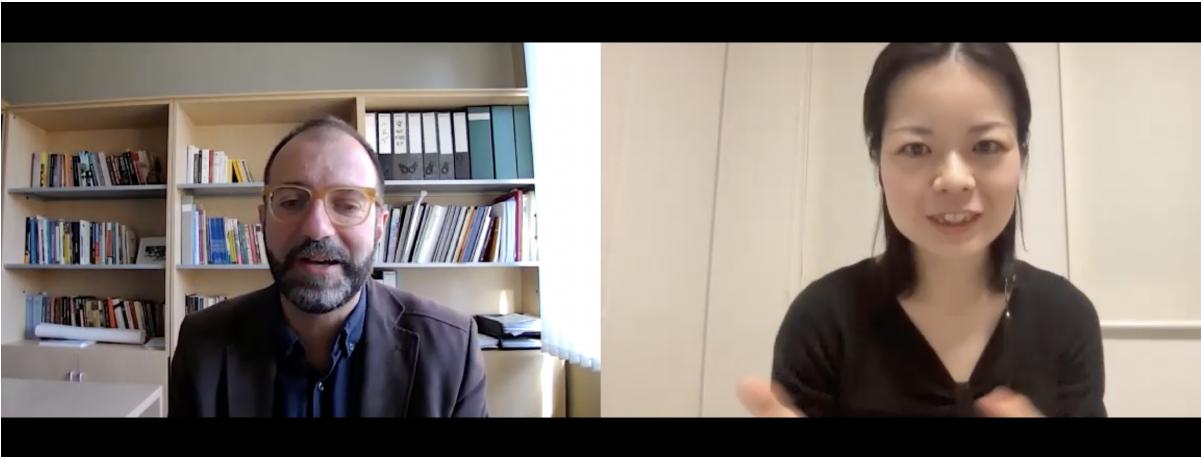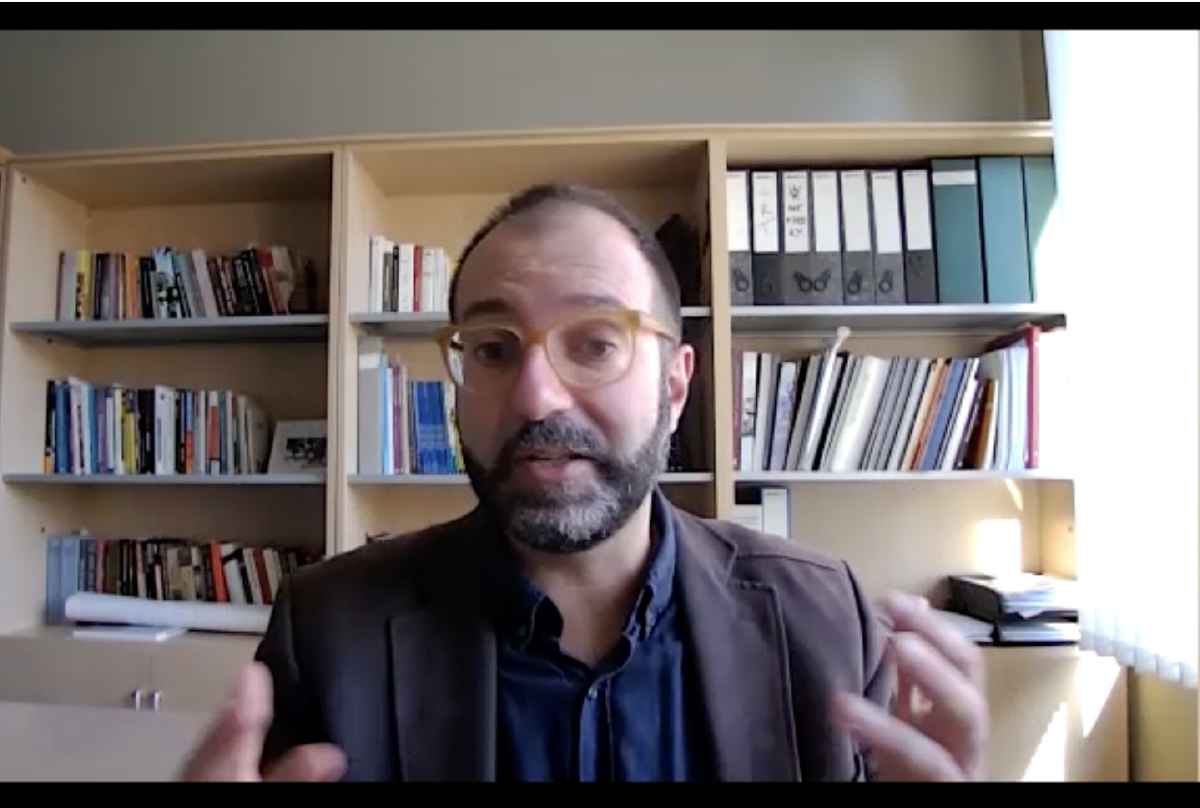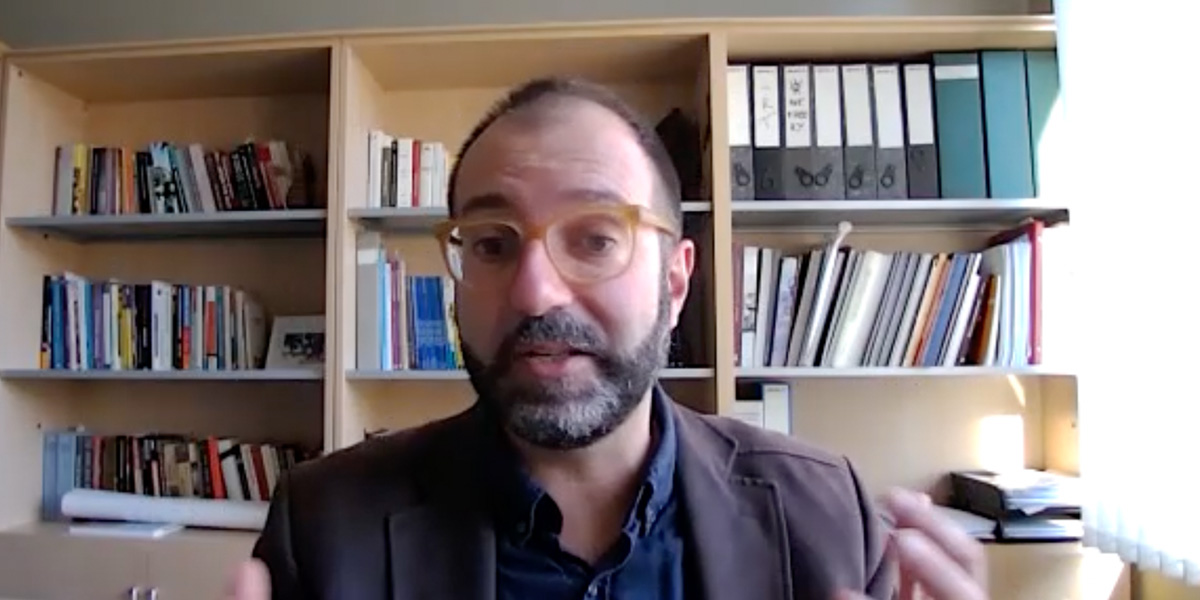まずCOVID-19のパンデミックをどのように経験されてきたのかから質問したいと思います。従来的なフィールドワークが困難な状況が、人類学やアートの研究にどのように影響しているのかも含めてお聞かせください。
I would like to start by asking how you have experienced the COVID-19 pandemic.
How did it affect the way you do research on art and anthropology without physical typical fieldwork?
初めのうちは休暇みたいでしたが、新しいCOVIDの波がやってくる度、カオスのような状態です。オミクロン株は感染拡大がすごく早いので、たくさんのミーティングがキャンセルされたり、学校が再びロックダウンされたり、本当に混乱状態です。パンデミックが落ち着くのをずっと心待ちにしていますが、終わりがないようにも感じています。
At the beginning, it was like a holiday. But then it became more chaotic with each new wave of COVID. Now with the Omicron variant it’s spreading very fast and many meetings are being canceled, schools have lockdowns again…It is very confusing. I’ve been looking forward to the end of the pandemic for a long time, and it seems to never end.
研究に関して言えば、いまはアートには直接的な関係はないのですが、モビリティについてのプロジェクトを抱えています。調査に出られない状況が続いています。いくつかのフィールドワークの計画はキャンセルになりました。オンライン上で人と会うことや会議がとても増えましたね。オンラインの良いところは、時間やお金が節約できるところですが、悪い面もあります。実際に旅をして人と会うということはアカデミアの良い側面ですが、それが出来なくなってしまっています。[コロナ禍で]オンラインで会いましょうという依頼が本当に増えました。もうひとつ良い点は、リアルでは起こらなかったような出会いがあるということですね。なのでこのインタヴューのように新しい機会をもたらすということもあると思います。
In terms of my own research, which is not directly related to art now, I have a project on mobility. Obviously I couldn’t do anything. I had a series of research trips planned but everything was canceled. We had to make many meetings online. This has a good side, because it saves money and time, but it also has a bad side. One of the good things in academia is traveling to meet people, but not anymore. People keep asking me to meet online. The good part is that some of this meetings would have never happened physically, so it opens new opportunities, like this interview I guess.
2012年以降のバルセロナと社会的なアート実践の衰退
The Decline of Social Art Practices after 2012 in Barcelona
現在はモビリティについてのプロジェクトに携わっておられるということですが、アートについてはもう研究なされないのですか?
You work on a research project on mobility. What about the research on art?
アーティストたちとの仕事も続けていますよ。ただそれは今の私の主な焦点という訳ではないです。というのも、2012年のクライシス(*1)以降、ここ10年くらいで、少なくともバルセロナに関して言えば、状況がすっかり変わってしまったからです。経済危機のために生まれた新しい政治運動との関わりで、ある種のアクティビスト・アートも目立つようになりました。でもその波は消えてしまった。ここで言う社会・政治運動とは、スペインのM15運動(*2)や[ニューヨークの]オキュパイ運動などのことです。スペインでは、その運動に関わっていた人たちの一部が政党を立ち上げて、その政党が芸術文化関係と奇妙な関係になっているというのが現状です。
I still work with some artists. I wouldn’t say it’s my main focus, I think because of the changes in the last ten years, at least in Barcelona after the crisis in 2012. There was a moment in which activist art emerged in connection with new political movements after the crisis, but that wave has gone. I mean, social movements like 15-M in Spain, or Occupy Wall Street, all these waves have ended. Some parts of this movement became political parties, and these political parties have a strange relationship with art.
*2 M15運動(Anti-austerity movement、通称15-M):2011年から2012年にかけてスペインで行われた緊縮財政反対運動。とくに若年層の失業率の上昇、社会福祉の削減などを背景に、より良い民主主義のあり方を求める運動としてニューヨークのオキュパイ運動などにも影響を与えたと言われている。
https://en.wikipedia.org/wiki/Anti-austerity_movement_in_Spain
良い関係ではないのですね。
It’s not a good relationship.
良い関係とは思えないですね。私も、新しくできた政党の初めのいくつかのミーティングに関わっていました。そこには芸術文化分野の人たちもたくさんいましたが、彼らのあいだには強い緊張関係がありました。現代美術をブルジョア的でエキセントリックなものや贅沢品として見なすような、とても古典的な芸術観を持つ人もたくさんいたからです。これらの新しい政党にとって、アートは二番目か三番目かあるいは四番目か、とにかく優先度が低かった。とても奇妙だけど。ミーティングには現代美術の関係者もたくさんいたのに、アンチ・アート的な感情がそこにはありました。
No, I don’t think it is. I was involved in some of the first meetings of these new political parties,. Lots of people from the art and cultural sector were also involved, but there was a strong tension among them. There were those who had a very classical understandings of art. They considered contemporary art as bourgeois eccentricity and luxury. For these new political parties, art was not a priority, maybe the second or the third or a fourth, which was very strange, because at the same time there were people from contemporary art involved in these meetings.This anti-art feeling was very present.
バルセロナとカタルーニャではここ10年の間、とても強い独立運動が行われてきました。現代美術シーン自体は、独立運動とはほとんど関係ありません。2000年代初頭の社会的、政治的なアートはコスモポリタンな性格のものでしたね。反グローバル化運動も、コスモポリタンなものでした。運動に関わる人は、さまざまな場所で活動し、世界中を移動していました。だから、そういったバックグラウンドをもつ人にとって、独立運動はある意味では奇妙で、そこにも緊張関係があったのだと思います。
In Barcelona and Catalunya there has been a very strong independence movement in the last decade. The contemporary art scene itself was not really involved in this movement. Social and political art in the early 2000s was really cosmopolitan, the Anti-globalization movement was very cosmopolitan. People were working in different locations and traveling around. When you were a part of this anti-globalization movement, or you come from that background, the independence movement sounded kind of weird and there were tensions, I guess.
何よりバルセロナの現代美術シーン自体がとても小さいですし、経済危機によってさらに縮小し、ますます内部争いが増えているように思えます。そういうことには私自身全く興味がないですしね。今でもアーティストたちとリサーチや展覧会に関わる仕事をしています。でも現在のバルセロナでは、社会的なアートや政治的なアートの波は消えてしまいました。うまくいけば、また何か別の形でそのようなアートが現れてくるかもしれません。でも私にとって15年前、20年前と直接的に関係するような現代のアート実践が見あたらないんです。少なくともバルセロナでは。
In Barcelona there is a very small contemporary art scene and it became smaller with the crisis, with lots of in-fights I’m not interested in. I still work with different artists and participate in research projects and exhibits, but I guess at the moment, social art and political art in Barcelona is gone. Something else hopefully, will come out. But I don’t see contemporary art as relevant as it was 15 years or 20 years ago, at least in Barcelona.
アートと生活を超えて
Beyond Art and Life
問うべきは、政治的なアート、社会的なアートについてのナラティヴがすべて、アートが日常生活に消えていくというものであることです。それ自体は、20世紀からつづく語り口です。さまざまなアプローチや戦略がとられてきました。例えば2000年代前半には「関係性の美学」というアプローチがありましたね。美術館などで展示できるようなアート作品へと日常生活を変換しするという戦略は、おそらく十分ではないのでしょう。何かが欠けているのだと思います。そのオルタナティヴはまだ見つかっていませんが、今後に期待しましょう。
The question is that the whole narrative about political art and social art is about the disappearance of art in everyday life. There have been different strategies, different ways of approaching it since the 20th century. One of the ways of approaching it in the early 2000s was relational aesthetics. It was about transforming everyday life into a form of art that can be displayed in the museums. But that probably wasn’t enough and there probably was something missing there. I don’t think we have found the alternative, so we will see what happens.
過去10年間の変化として、いわゆるソーシャル・アート・プラクティス(social art practice)と呼ばれるような[政治的なアート、社会的なアートの]取り組みが一つのジャンルになってしまった印象があります。学位ができたりね。先ほども言ったように、問わなければいけないのは、アートをつくることが日常に消えていくということで、もしソーシャル・アート・プラクティスが慣例になって、アートのジャンルの一つになるのなら、それはもはやうまく機能していないということになるでしょう。
My impression about what emerged in the past 10 years is that so-called social art practice has become a genre, with academic degrees in it. It’s going back to what I was saying before. The whole question is making art disappearing into everyday life. If social art practices become convention, they become genre, then it is not really working.
キュレーターについて
On Curators
とくに、社会的なアート実践におけるアーティストとキュレーター、人類学者の実践には共通点があると思います。キュレーターについての本を出版されました。(The Anthropologist as Curator, Routledge, 2019 )キュレーターとして仕事をしたことはありますか?
You edited a volume ‘The Anthropologist as Curator’. Do you work as a curator?
ない、ない、ない、ない…
No, no, no.
興味はありますか?
Are you interested in?
実はあまりないのです(笑)。私が編集しましたが、書いたのはイントロダクションだけです。キュレーションの経験がないからです。私が興味があるのは、人類学者に何が起こっているのかということで、批判的距離をおいた、古典的な人類学的視点から興味を持っているということです。でもおそらく、なぜ[自分がキュレーターの仕事をすることに関して]興味がないかもっと考えてみるべきでしょうね。私の親しい友人たちの何人かはキュレーターです。いつも周りにキュレータがいます。キュレーターも人類学者同様、ディスコースやナラティブを生み出していますね。
No, personally I’m not, Hahaha. I curated the volume, I only wrote the introduction, because I have no experience in curating. I’m always interested in what happens with anthropologists but from a very detached, very classical anthropological point of view. Perhaps I should ask myself why (I’m not interested in becoming a curator myself). You know, some of my best friends are curators. I’m constantly surrounded by curators. Curators, like anthropologists, build discourses and narratives.
かつては、キュレーションというのはある種のコントロールの一形態であり、アーティストの一群を方向づけることだと考えていました。単一のディスコースを多様なアート作品に押しつけるということです。でもキュレーションはそういうことではないということに気づきました。キュレーションの仕事というのはただ自分のディスコースを提示するというだけでなく、多くの仲介・媒介(メディエーション)や交渉の実践を含んでいます。それがとても面白いところです。私のような人類学者は、我々はもっと距離をおいた視点を取ることができて、もっと個人主義的だと考えがちです。でも実際は、私たちも一緒にはたらく人々と交渉したり協働したりしなければならないし、ときに仲介・媒介役にならないといけないですよね。なので私たちはそういった意味でキュレーターの仕事から多くを学ぶことができると考えるようになりました。仲介や外交的な手腕であったり、ある意味、異なったエージェントたちと一緒にはたらき、それらをまとめる術ですね。そういった部分を、私たちは[キュレーターたちから]学ぶことができると思います。
I used to see curation as a form of control trying to direct the group of artists. Imposing a unitary discourse to a variety of works of art. Then I realized that it’s not exactly like that. The work of curation is not just imposing your discourse, but it involves lots of practices of mediation and negotiation that are really interesting. Anthropologists like me think that we can take a more detached perspective, we can be more individualistic. But in fact, we also have to negotiate with people we are working with, we have to mediate. I ended up understanding that we could learn a lot from curatorial practices in that sense. Practices of mediation or practices of diplomacy, in a way trying to bring different agents together and assembling them, that is something I think we can learn.
ここには危険性もあります。過去数十年間におけるキュレーターの位置づけの変化です。アーティストとしてのキュレーターですね。言説をつくり上げる人、発言する人、この人について行けば有名になれるとか、そういう部分には私は興味がありません。でもそこには非常にわずかな差しかありません。私が興味をもっているのは、社会的なメディエーター(媒介者)としてのキュレーターという立ち位置です。多くの社会的なアート実践やコンセプチュアルアートを手がけるアーティストたちがやっていることともとても近いと言えます。キュレーターと同じく、メディエーターとしてのアーティストあるいはキュレーターは、ある意味でお互いを重ね合わせているようです。そこから人類学者は学ぶことができると思います。ただ私自身は、何らかのキュレーションのプロジェクトを行うことに躊躇しています。たとえ行ったとしても、展覧会にはならないでしょう。おそらく社会的な実践の協働キュレーションのようなものになるかもしれないです。まだ手がけたことはないですが。
The danger of this is obviously how the curators emerged in the last decades. Curators as artists, in a way. He is the one imposes the discourses, he’s the one who says what, you have to follow this curator because this curator makes you famous. That I’m not interested in. But it’s a very thin line. I am interested in the position of curator as a social mediator, there’s also very close to what many contemporary artists do, conceptual and social practice artists. It’s very similar. Artists and curators as mediators in a way are superposed to each other. That’s something we anthropologists can learn from. At the same time, I’m not sure about doing a curatorial project by myself. Even if I do a curatorial project, it would not be an exhibit, it would be something co-curatorial, socially engaged, but I haven’t done it so far.

さまざまなかたちの民族誌について
Various Types of Ethnography
最近はテクスト・ベースの伝統的な民族誌のオルタナティヴを見つけ出そうとする動きがとても強いと思います。
There have been a strong tendency to work on the alternative ways of making ethnography, apart from the text-based classic ethnography.
それは日本だけの傾向ではないですね。過去30年のあいだに、アート実践を社会的手法のオルタナティヴと見なすことが拡大してきました。書くという人類学者が行ってきたことの代わりに、たとえば映像や展示や写真などが手がけられてきたのです。もちろん、それは素晴らしいと思います。でもそれだけではないということですね。アーティストやキュレーターと話せば分かりますが、彼らが行っていることは本当に深い知識と広い情報に基づいたものです。彼らはたくさんのアイデアや議論を持っています。彼らの作品は、技術の問題だけではありません。アートの主流の議論は、反技術についてです。20世紀全体を通して、どのように芸術とまっさらな状態で向かい合う(アンラーニングする)のかが議論されてきたのです。芸術実践というのは技術面での専門知識というだけではありません。アーティストたちは、自分が関わっているメディウムや対象、社会的状況とコンセプチュアルな関係があることに自覚的でなければならない。アートというのは、ただ技術面を学ぶだけではないのです。もちろん、映像や写真などから多くを学ぶことはできます。でももしそれらを技術としてのみ見るだけでは、それは文章とあまり変わりません。
It’s not only in Japan. It’s everywhere. In the past 30 years, it has become quite wide spread to look at artistic practice as alternative social method. Instead of doing what anthropologists used to do, which is writing, you do films, or you do exhibits, you do pictures. This is absolutely fine, but it’s not just about that. If you really know and talk to curators and contemporary artists, what they are doing is really informed. There are lots of ideas, lots of discussions. Their work is not just a technique. A central discussion in art is precisely against techniques. During the whole 20th century, there has been a lot of discussion about unlearning art. Art practices are not just technical expertise. There is a conceptual engagement with the media, with your objects, with the social situation you’re dealing with, and you have to be aware of that. So, it’s not just leaning the technique. Of course, you can learn a lot from film and you can learn a lot from photography, but if you look at them as techniques, they are not very different from writing.
最終的に、展覧会や映像も、もの(object)です。学位論文や単著がものというのと同じように。ゴールドスミスには視覚人類学のとても強力なプログラムがありました。そこで働いていた際、PhDの学位についての議論が盛んになされました。博士論文のうちどのくらいの分量の文章が書かれるべきか? 論文と短編映像? あるいは映像作品だけで論文はなくてもいいのか? いやいや、何か書いたものが必要だろう…でももし写真だったら? 何枚の写真が必要なことにしようか? このような議論は、私にとってあまり興味深いものではありませんでした。もし言葉をイメージに置き換えているだけであれば、そんな議論は全く意味がないからです。
Ultimately, exhibits or films are objects, just like a dissertation or a monograph is an object. There was a strong program of visual anthropology at Goldsmith. When I worked there, there were many discussions about visual anthropology PhDs degrees. What proportion of the dissertation do we need to be written? Maybe dissertation and a short film? Maybe only film and nothing written? No, no, there has to be something written… And if they do photographs, how many photographs do we need?These discussions were not very interesting to me. If it’s just about replacing words with images, the discussion becomes totally pointless.
問題は、書くことや書いたものに関してというより、非常に厳格な大学や学問のシステムにあると思います。そのシステムが人々にあれこれ命じるのです。もしも従来的なアカデミックな仕事をしたいわけでないのならば、ジャーナルのためのうっとうしい論文や単著や学位論文ではなく、より自由に何かを書きたいのであれば、それもいいでしょう。でも、そうするとアカデミックな生産システムからは弾かれてしまいます。逆説的に、みんなこの非常に窮屈なアカデミックシステムの一部になりたいとも思っています。アカデミアで安定した職を得たいから。問題は、アカデミアの内で私たちが生産するものにあるのではないのです。映画やアート作品を本や論文と置き換えることが解決策にはならないと思います。もしも違ったやり方で仕事や生活をしたいのであれば、アカデミアの世界がどのように機能しているのかを変えなければならないと思います。私たちの生産するものだけではなくて。
But the whole problem is not about writing, the problem is you have a very rigid academic system that requires people to go through academic programs to study, do the PhD, etc. If you don’t want to do a conventional academic work, you don’t want to write annoying papers for journals and write a monograph and dissertation, but you want to do various more open, more free things, that’s fine. But that implies a rejection of the academic system of production. Parodixically, then people want to become a part of this very rigid academic system, because they want to get a stable job in academia. I think the problema is not the kinds of products we make in academia, the solution is not to replace books with films or works of art. If we want to work differently, live differently, we should change how academia works, not just the products of our work.
多くの芸術実践が再びアカデミックになっています。アーティストたちも学位が必要だからです。常勤職に就きたいからです。もし大学の講師になりたいのならば、PhDが必要です。多くの芸術実践がアカデミックになっていて、皆がそれに従う必要があるのです。生きていかなければならないから。十分理解できることです。
Lots of art practice have become academic again, because artists need degrees. They want to have a permanent job. If you want to be a university lecturer, you need to have PhD, so a lot of art practice becomes academic, because you have to conform to this, because you need to live. That’s understandable.
アカデミアと決別するアートというアイデアは、アカデミアや官僚主義から逃れようとする人類学者と全く同じことです。私の経験からすると、[人類学者が]アート実践に携わることは、私たちを駆り立てます。なぜアート的実践を志向するのかについて、まず深く考えてみる必要があると思います。アカデミックな知識が生み出される方法に疑問があり、いかに自分がその一部になっているのか。そして本当にそれが嫌ならば、アカデミックシステムがどのように機能しているのかを問わないといけないですね。
This idea of art breaking with academia is the same as all the ideas about anthropologists trying to escape from academia and bureaucracy. Doing art, in my experience, drive us very far. You have to have deeper reflection on why you go to art first. Because you are not happy with the way academic knowledge is being produced and how you are part of it. So, if you are really not happy with that, what you have to do is questioning how it (this system) works.
最近では博士課程を3年で終える必要があるなんて言われていますが、歴史的に見ると人類学の研究は一生かかるものです。それでもかつては良かったんです。でも今では、とても早く仕上げないといけない。何ページ必要で、写真は何枚で、どれくらいで…といったアカデミックなトレーニングにはうんざりします。そしてアートは私たちを救うわけではないのです。アートも同じ罠にはまっているから。そしてもしあなたが、そういった官僚主義的な、ネオリベラルな大学システムと戦いたいならば、直にその問題に取り組まなければならない。アート実践を用いたりするのではなくて。
It is said that PhD students have to finish in three years, otherwise it’s not good. Historically, it took us forever to do anthropology and that was fine. It was fine, really. But now no, you have to finish very quickly. Well, how many pages, how many photographs, how many.. there’s a whole training we are not happy with. But art will not save us, because art is in the same trap. And if you want to fight with, whatever you call, bureaucratic, neoliberal university system, you have to address it directly, not through art practices.
アートは、知識を生み出す方法を変えるために、私たちが同盟を組むことができるものです。でもアーティストたちも、人類学者/学者と同じ問題に直面しているということを忘れてはなりません。
Art can be an ally for us into changing the way to produce knowledge, but artists are facing the same problems we are.
アーティストも若手の研究者も、不安定な身分という点で共通していると言えます。
Both artists and younger researchers are facing the precarious situations.
アーティスト[の状況]はもっとひどいし、もっと不安定ですね。助成金に応募したり、いつもレジデンスに行って、私たちよりも常に何かに備えていないければならないと思います。それに、とても競争が激しい。永遠に年をとらず、永遠に作品を作りつづけるなんて、実際、現実的ではないですよね。それに、この枠組み自体とてもジェンダー化されています。現在でも、このようなやり方は一般的に言って女性に簡単なことではないでしょう。子どもがいたらどうしますか? ニューヨークやロンドン、ベルリンと移り住んでいかなければならないとしたら。だから[アーティストたちも]みんな安定した仕事と給料を、例えばアカデミアで、得る必要があるのだと思います。でも同時に、アカデミア、大学にもいくつもの制限があります。アーティストと人類学者は、現状を変えるために、一緒に働くことができるだろうというのははっきりと言えることです。
Artists are more precarious than academics, they have to apply for grants and residencies all the time and they have to be so much more prepared than we are. And it’s very competitive. You are supposed to be young forever, supposed to be producing art forever and it’s just not realistic, right? All this framework is also very gendered. In many ways, it’s not so easy for women in general still nowadays. If you have children, what do you supposed to do? Moving from New York to London to Berlin and… So I understand people have to get more stable jobs, to get a salary, for example in academia. But at the same time, academia has a number of constraints. Artists and anthropologists can work together towards something different.
やっとポジティヴな将来の展望が見えてきました。
That’s finally a positive future view!
自分がとても悲観的だというのは分かっています(笑)。反グローバル運動ではクリティカルマスというアイデアがありました。「どれくらい多くの人が同じ状況に直面しているかに目を向けて!」そして、みんなが団結すればどうでしょう。マルクスの「万国の労働者よ、団結せよ!」みたいに聞こえますね。でも21世紀初頭に言われたことです。「万国の知的労働者よ、団結せよ」や、あるいはそれと似たようなものです。どうすれば異なったやり方をできるのか?どうすればちがう大学をつくることができるのか、どのように異なったやり方でアートと生きることができるのか? 同じような問題に直面している人はたくさんいます。アーティスト、作家、学者たち。何かがが起こるでしょう。そうするのが、ネオリベラルな官僚主義的マシーンに組み込まれない未だ唯一の方法だと思います。日本ではどのような状況か分かりませんが、おそらく同じような状況でしょう(笑)。
I know I sound very pessimistic. In the anti globalization movement there was this idea of a critical mass “Look at how many people in the same situation!”,what if we get organized?. That sounds like Marx “workers of the world, unite!” That’s what was said in the beginning of 21st century, right? “ Cognitive workers of the world, unite!” Or something similar to that. How can we do this differently, how can we make a different university, how can we live with art in different ways? There is lots of us, artists, writers, scholars, something might happen. I think that’s still the only way forward not to fall into bureaucratic machines of neoliberalism. I don’t know what’s going on in Japan, but probably the same. Ha ha ha…
そうですね、程度の差はあるとは思いますが。
Yes, more or less…
パンデミックと社会的なアート
Pandemic and Social Art Practices
パンデミック下で印象に残っている作品やプロジェクトはありますか?
Are there any artworks or projects you’re interested in during the pandemic?
ソーシャル・アート・プラクティスにおいては本来、身体的で実際的な接触が重要でした。それが[パンデミックで]難しい状況に置かれてきました。バルセロナのMACBAで、フェリックス・ゴンザレス・トレスの展覧会がありました。[観客が]キャンディを取っていく作品では、「COVIDのためキャンディーをとるのは一つだけ」という張り紙がしてありました(笑)。意味がわかりません。今回のパンデミックは、人と会ったり、何かを人と交換したり、ときには人に触れたり、というソーシャリー・エンゲイジド・アートの基礎に反するものです。
Social art practice in the classic understanding, with actual physical contact have been in a critical situation. There was an exhibition of Felix Gonzales Torres in Barcelona during the pandemic. You remember his works taking candies or posters with you, right? There was an indication at MACBA. “Because of COVID you can take only one candy.” I have no idea why. This pandemic goes against the very foundation of socially engaged art, which is about meeting people and exchanging stuff with people, even touching people.
パンデミックは社会的な状況への渇望を目覚めさせるでしょう。スペインでは、アートとは関係ありませんが、ティーンエイジャーたちは人に会いたくて仕方がありません。だから通りの真ん中で突発的にパーティーを始めたりしていますよ。アートに関して言えば、ありきたりかもしれませんが、2024年にバルセロナで開催されるマニフェスタを挙げることができます。パンデミックの変化というのを目の当たりにする機会になるかもしれないですね。その頃にはおそらく「パンデミック後」になっているでしょうしね。それ[社会的なアート]がどうなるか、そこで分かるかもしれないですね。
It will awake a hunger to return to social situations. At least in Spain, this has nothing to do with art, but you know, teenagers are hungry for meeting people, so they are organizing spontaneous parties in the middle of street. Concerning art practices, it can be a cliche but Manifesta, an European traveling contemporary art festival, will be held in 2024 in Barcelona. It will be an opportunity to see what will happen. Maybe 2024 will be after the pandemic, right? We will see if it comes back to life.
そうですね、今後2年どんなことが起こっていくのかを考えるのは面白いですね。
Yes, it’s interesting to think further what will be happening within 2 years.
そう、未来に望みをかけないといけないですね。期待しましょう。
Yes, we have to look for future, right? Let’s hope.
(2022/01/18 オンラインにて、聞き手:登久希子)

現在、スペインのバルセロナ大学で人類学の教授をつとめる。ロンドン大学のゴールドスミス・カレッジ、シカゴ大学などで教鞭をとってきた。‘Art, Anthropology and the Gift’(Bloomsbery Press, 2014)や’Sorcery in the Black Atlantic’(University of Chicago Press, 2011)など著書多数。ANTART(人類学とアートネットワーク)の設立者でもある。
Roger Sansi is Professor of Anthropology at the University of Barcelona, Spain.
He has taught in several universities, notably Goldsmiths, University of London and the University of Chicago. The author of many books, including ‘Art, Anthropology and the Gift’ (Bloomsbery Press, 2014) and ’Sorcery in the Black Atlantic’ (University of Chicago Press, 2011). Is a founding convenor of ANTART (Anthropology and Art Network).


